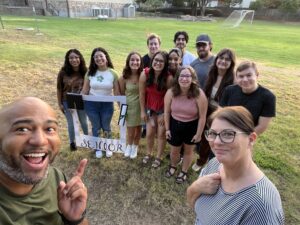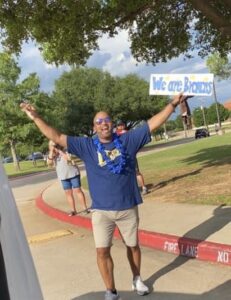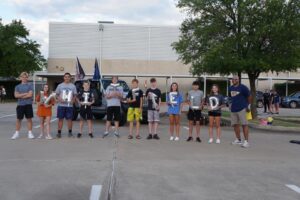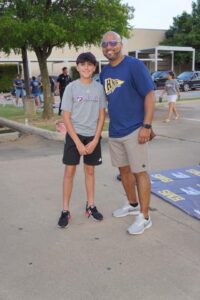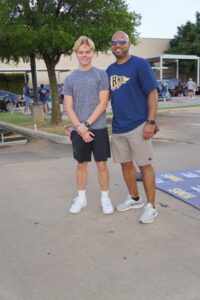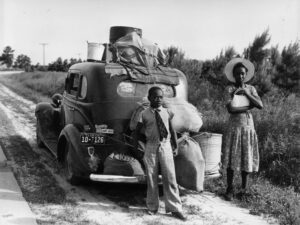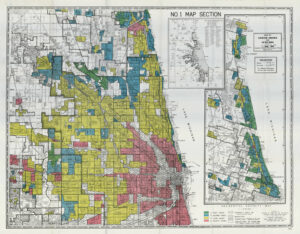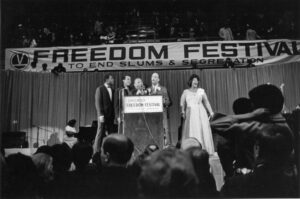The water rushes in, pushing up through the asphalt and out onto the front lawn of one of our buildings.
Our nearby creek rapidly fills as the water crashes over the banks, onto the stone wall below, and into the once calm flowing waters. The water climbs at an alarming rate, and I fear the worst – our building is going to flood. And the road that is impacted is a main thoroughfare between the two sides of our expansive campus.
Standing on the road above the rushing water, I connect with emergency services, who quickly dispatch a police officer to close off the road. A water main had burst and, within the hour, city services were out to attempt to slow the flow of water.
A Test of Flexibility
It’s just before dismissal, and nothing about normal operating procedures will be in play. In a moment’s notice, everything has flipped upside down, and we have to just figure it out.
I’ll spare you the logistical gymnastics that our staff, students, and families had to navigate from last Friday evening until Wednesday afternoon of this past week; but anyone who has ever been through, or worked, a car rider line at a school knows how critical routines and procedures are to this process. This promised to be a test of our flexibility. And we passed that test with flying colors, as a community.
Our Response Matters
This event is symbolic of so many of life’s chaotic moments. Throughout our life, we are faced with various challenges. Some greater than others, but challenges, nonetheless. And what I’ve found to be true through these moments is that it is our response that makes all the difference in the world. Challenges don’t care about our schedules or plans; they arrive unannounced, demanding our full attention. Yet, it’s not the challenge itself that defines us; it’s our response.
When these events arise, we’re on stage. People may be looking to us to gauge how they should feel or respond. I know that may sound strange, but it’s true. Think of it this way:
A toddler falls and scrapes their knee on the playground. Immediately, they look to their parent or caregiver and begin to gauge “ok, how bad is this?” If the parent/caregiver jumps up and screams bloody murder, the kid begins to scream. If the parent/caregiver remains cool, calm, and collected, chances are, the child mimicked that very behavior. They’re watching to see how we respond.
Leadership in Crisis
It’s much the same in society. When these events play out, people are watching to see how we respond. Are we losing our ever-loving mind, wandering aimlessly? Or are we cool, calm, and collected, managing the crisis? These moments stand as a test of leadership. The response to chaos and/or conflict sends a resounding message to those who look to us for guidance.
And, many times, that is within our own homes. Kids mimicking our behavior. They hang on to every word. Even though it doesn’t seem like it most of the time, they are listening and watching how we respond. In doing so, they are capturing deep, impactful lessons on how to deal with chaos, disagreement, and conflict. And They will carry these lessons forward as they navigate the days ahead.
So, as we’re met with these moments, we must capitalize on the teachable moments they bring both in our homes and in society as a whole.
There’s Power in the Pause
Take time to pause when met with the moment. So often we’re quick to rush into panic mode, and rarely does that serve us well. Instead, give yourself a moment to take a deep breath, collect yourself, and reflect. You’ll find a deeper sense of clarity as to how to proceed.
Communication is Key
The way you communicate in these moments is key. Clear, calm, and consistent communication helps create a sense of serenity. Even if you don’t have all the answers, communicate that. People will appreciate the vulnerability you’ve shown by addressing the fact that you don’t have it all figured out. The worst thing you can do is pretend you do, or share information too early that may be counter to the realities that may lie ahead. Share what you know. Acknowledge what you don’t know. And assure them that, as soon as you do know, you’ll let them know. Then communicate when you do. Most every time I’ve seen things go off the rails, whether in moments of chaos or not, it comes down to communication gaps. Never underestimate the powerful role communication plays. Additionally, remember that communication is not only about what we say; it’s our body language and tone, as well.
Teamwork Makes the Dream Work
In these moments, it’s critical to rally the troops. You cannot get through these times of chaos alone. It takes a concerted team effort to successfully navigate these times. Lean on your people. Collaborate with them to find viable solutions. Empower them to lead in their respective spaces. And trust them to perform. Collaboration is key to successfully navigating the turbulence. Your team will come out stronger on the other side.
Smile
Don’t be afraid to smile. Sure, this may be a crazy challenge before you, but your ability to smile through it will reverberate through the community you serve. Remember, communication has a great deal to do with body language and a smile…well…it’s really hard to not smile back at someone who is smiling at you. So, while the winds may have shifted, and this moment may be tough, our ability to smile through it helps strengthen our resolve.
Reflection
The challenges that crop up along our journey can be unrelenting and paralyzing at times. While this is, in no way, an exhaustive list of the skills and mindset required to navigate these scenarios effectively, they have been elements that have helped me on my journey. And it is my hope that possibly, in some small way, they may help you. As we round out the week I’d like to challenge you to reflect on the latest “water main break” in your life. Ask yourself:
What did the people who count on me see from me through that challenge?
How did I communicate?
What did I do well?
What could I have done better?
Reflection is key to growth. And if we’re honest with ourselves in answering those questions, growth will come.
I am so grateful you’ve joined me on this journey throughout 2023. Thanks for being here.
